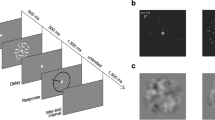Abstract
Thresholds were measured for a moving line superimposed on moving sinusoidal gratings. When line and grating moved in the same direction significant subthreshold summation was observed over a range of spatial frequencies. For motion of the line and grating in opposite directions, summation was never observed. This supports the hypothesis that direction selective mechanisms are responsible for motion perception at threshold. Further analysis of the data produced estimates of the spatial frequency tuning of these mechanisms. A quantitative model is proposed to interpret the data, and it is suggested that flickering gratings are not decomposed into their moving components by the visual system.
Similar content being viewed by others
References
Adelson, E.H., Bergen, J.R.: Spatiotemporal energy models for the perception of motion. Presented at the Annual Meeting, Optical Society of America, October, 1983
Barlow, H.B., Levick, W.R.: The mechanism of directionally selective units in rabbit's retina. J. Physiol. 178, 477–504 (1965)
Bergen, J.R., Wilson, H.R.: Prediction of flicker sensitivities from temporal pulse data. Vision Res. (in press, 1985)
Bishop, P.O., Coombs, J.S., Henry, G.H.: Responses to visual contours: spatio-temporal aspects of excitation in the receptive fields of simple striate neurons. J. Physiol. 219, 625–657 (1971)
Burt, P.J.: Time-space limits on information processing in early vision: a computational perspective. Presented at the Annual Meeting, Optical Society of America, October, 1983
Crane, H.D., Steele, C.M.: Accurate three-dimensional eyetacker. Appl. Opt. 17, 619–705 (1978)
Foster, D.H.: A model of the human visual system in its response to certain classes of moving stimuli. Kybernetik 8, 69–84 (1971)
Ganz, L.: Properties of cortical inhibition in directionally selective neurons: some neurophysiological parallels to the perception of movement. In: Visual psychophysics and physiology. Pp. 115–126. Armington, J.C., Krauskopf, J., Wooten, B.R., eds New York: Academic Press 1978
Goodwin, A.W., Henry, G.H., Bishop, P.O.: Direction selectivity of simple striate cells: properties and mechanism. J. Neurophysiol. 38, 1500–1523 (1975)
Hubel, D.H., Wiesel, T.N.: Receptive fields, binocular interaction and functional architecture in the cat's visual cortex. J. Physiol. 160, 106–154 (1962)
Hubel, D.H., Wiesel, T.N.: Receptive fields and functional architecture of monkey striate cortex. J. Physiol. 195, 215–243 (1968)
Kelly, D.H.: Motion and vision. II. Stabilized spatio-temporal threshold surface. J. Opt. Soc. Am. 69, 1340–1349 (1979)
Kulikowski, J.J., King-Smith, P.E.: Spatial arrangement of line, edge, and grating detectors revealed by subthreshold summation. Vision Res. 13, 1455–1478 (1973)
Levinson, E., Sekuler, R.: The independence of channels in human vision selective for direction of movement. J. Physiol. 250 347–366 (1975)
Levinson, E., Sekuler, R.: A two-dimensional analysis of direction-specific adaptation. Vision Res. 20 103–107 (1980)
Movshon, J.A.: The velocity tuning of single units in cat striate cortex. J. Physiol. 249, 445–468 (1975)
Movshon, J.A., Thompson, I.D., Tolhurst, D.J.: Receptive field organization of complex cells in the cat's striate cortex. J. Physiol. 283, 53–77 (1978)
Orban, G.A., Kennedy, H., Maes, H.: Response to movement of neurons in areas 17 and 18 of the cat: velocity sensitivity. J. Neurophysiol. 45, 1043–1058 (1981a)
Orban, G.A., Kennedy, H., Maes, H.: Response to movement of neurons in areas 17 and 18 of the cat: direction selectivity. J. Neurophysiol. 45, 1059–1073 (1981b)
Peichl, L., Wassle, H. Size, scatter and coverage of ganglion cell receptive field centers in the cat retina. J. Physiol. 291, 117–141 (1979)
Poggio, T., Reichardt, W.: Considerations on models of movement detection. Kybernetik 13, 223–227 (1973)
Quick, R.F.: A vector-magnitude model of contrast detection Kybernetick 16, 65–67 (1974)
Rashbass, C.: The visibility of transient changes of luminance. J. Physiol. 210 165–186 (1970)
Reichardt, W., Poggio, T.: Visual control of orientation behavior in the fly. Q. Rev. Biophys. 9, 311–438 (1976)
Reichardt, W., Varju, D.: Übertragungseigenschaften im Auswertesystem für das Bewegungssehen. Z. Naturforsch. 14b, 674–689 (1959)
Robson, J.G.: Receptive fields: neural representation of the spatial and intensive attributes of the visual image. In: Handbook of perception seeing. Vol. V, pp. 81–116. Carterette, E.C., Friedman, M.P. eds. New York: Academic Press 1975
Sakitt, B., Barlow, H.B.: A model for the economical encoding of the visual image in cerebral cortex. Biol. Cybern. 43, 97–108 (1982)
Schouten, J.F.: Subjective stroboscopy and a model of visual movement detectors. In: Models for the perception of speech and visual form. pp. 44–55. Wathen-Dunn, W., ed. Cambridge, MA: MIT Press 1967
Sekuler, R., Ganz, L.: A new aftereffect of seen movement with a stabilized retinal image. Science 139, 419–420 (1963)
Thorson, J.: Small signal analysis of a visual reflex in the locust. II. Frequency dependence. Kybernetik 3, 53–66 (1966)
Tolhurst, D.J., Movshon, J.A.: Spatial and temporal contrast sensitivity of striate contical neurones. Nature 257, 674–675 (1975)
Torre, V., Poggio, T.: A synaptic mechanism possibly underlying directional selectivity to motion. Proc. Roy. Soc. Lond. B 202, 409–416 (1978)
vanSanten, J.P.H., Sperling, G.: A temporal covariance model for motion perception. Invest. Opthalmol. Vis. Sci. [Suppl.] 24, 277 (1983)
Watson, A.B., Nachmias, J.: Patterns of temoral interaction in the detection of grating. Vision Res. 17, 893–902 (1977)
Watson, A.B., Thompson, P.G., Murphy, B.J., Nachmias, J.: Summation and discrimination of gratings moving in opposite directions. Vision Res. 20 341–347 (1980)
Watson, A.B.: Probability summation over time. Vision Res. 19, 515–522 (1979)
Wilson, H.R., Bergen, J.R.: A four mechanism model for threshold spatial vision. Vision Res. 19, 19–32 (1979)
Wilson, H.R.: Spatiotemporal characterization of a transient mechanism in the human visual system. Vision Res. 20, 433–452 (1980)
Wilson, H.R., McFarlane, D.K., Phillips, G.C. Spatial frequency tuning of orientation selective units estimated by oblique masking. Vision Res. 23, 873–882 (1983)
Wilson, H.R., Gelb, D.J.: A modified line element theory for spatial frequency and width discrimination. J. Opt. Soc. Am. A 1, 124–131 (1984)
Author information
Authors and Affiliations
Rights and permissions
About this article
Cite this article
Wilson, H.R. A model for direction selectivity in threshold motion perception. Biol. Cybern. 51, 213–222 (1985). https://doi.org/10.1007/BF00337147
Received:
Issue Date:
DOI: https://doi.org/10.1007/BF00337147




